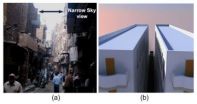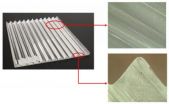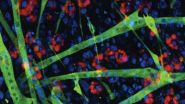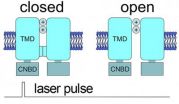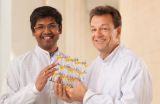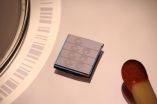(Press-News.org) WASHINGTON, April 14—In dense, urban centers around the world, many people live and work in dim and narrow streets surrounded by tall buildings that block sunlight. And as the global population continues to rise and buildings are jammed closer together, the darkness will only spread.
To alleviate the problem, Egyptian researchers have developed a corrugated, translucent panel that redirects sunlight onto narrow streets and alleyways. The panel is mounted on rooftops and hung over the edge at an angle, where it spreads sunlight onto the street below. The researchers describe their design in a paper published today in Energy Express, a supplement of The Optical Society's (OSA) open-access journal Optics Express.
"We expect the device to provide illumination to perform everyday tasks, and improve the quality of light and health conditions in dark areas," said Amr Safwat, a professor of electronics and communications engineering at Ain Shams University in Cairo, Egypt. These dimly lit areas specifically include narrow streets in developing countries, but Safwat said the new panel could be used in any country as a greener, cheaper, and more pleasant alternative to fluorescent and other artificial light.
While other commercially available window-like devices can redirect light, they are designed for shade and redirecting glare or for brightening a room—not a narrow street. So the researchers decided to create their own design. They wanted a simple way to redistribute natural light without the need for a tracking device that follows the rising and setting sun.
What they came up with is a panel made of polymethyl methacrylate (PMMA), the same acrylic plastic of which Plexiglas is made. The bottom of the panel is smooth while the top is covered in ridges that are based on a sine wave, the mathematical function that describes everything from light to pendulums. The researchers used computer simulations to find the size and shape of the grooves that distribute the most amount of sunlight in a wide range of sun positions all year round, whether it's high or low in the sky. A sine-wave pattern is also easy to manufacture.
Using simulations of sunlight shining on an alleyway, the researchers found that their panels increased illumination by 200 percent and 400 percent in autumn and winter, respectively, when sunlight is most limited. They also tested a small prototype over a 0.4-meter-by-0.4-meter shaft that is 1.2-meters deep and found that it lit up the area as designed.
The next step, Safwat said, will be to build a full-scale model 10 times bigger to validate their calculations and to test it in a real alleyway. The team then plans to market and commercialize the panel. He estimates that a one-square-meter panel and a frame will cost between $70 and $100.
And that may be a small price to pay for the benefits of sunlight. The lack of sun in urban areas doesn't just make life gloomy; it can be harmful to your health, Safwat said.
"Research has shown that lack of natural lighting can cause severe physiological problems," such as serious mood changes, excessive sleeping, loss of energy and depression, Safwat said.
He also noted that using sunlight to illuminate historical places—such as ancient alleyways in Egypt—also helps preserve the authenticity of the site, maintaining its cultural value and historical significance.
INFORMATION:
This work was funded by the Science and Technology Development Fund of Egypt.
Paper: "Illumination of dense urban areas by light redirecting panels," S. I. El-Hanawy, et al., Optics Express, Vol. 22, Issue S3, pp. A895-A907 (2014). http://www.opticsinfobase.org/oe/abstract.cfm?uri=oe-22-103-A895
EDITOR'S NOTE: High-resolution images are available to members of the media upon request. Contact Angela Stark, astark@osa.org.
About Energy Express
The Optical Society's (OSA) premier open-access journal, Optics Express, publishes a bimonthly supplement, Energy Express. This supplement is dedicated to new developments in the science and engineering of light and their impact on sustainable energy, the environment, and green technologies. It is led by Editor Christian Seassal from CNRS, University of Lyon, France and is available at no cost to readers online at http://www.OpticsInfoBase.org/EE.
About Optics Express
Optics Express reports on new developments in all fields of optical science and technology every two weeks. The journal provides rapid publication of original, peer-reviewed papers. It is published by The Optical Society and edited by Andrew M. Weiner of Purdue University. Optics Express is an open-access journal and is available at no cost to readers online at http://www.OpticsInfoBase.org/OE.
About OSA
Founded in 1916, The Optical Society (OSA) is the leading professional society for scientists, engineers, students and business leaders who fuel discoveries, shape real-world applications and accelerate achievements in the science of light. Through world-renowned publications, meetings and membership programs, OSA provides quality research, inspired interactions and dedicated resources for its extensive global network of professionals in optics and photonics. For more information, visit http://www.osa.org.
Let the sun shine in: Redirecting sunlight to urban alleyways
Optical devices could bring natural light into dark, highly populated areas
2014-04-14
ELSE PRESS RELEASES FROM THIS DATE:
Wolves at the door: Study finds recent wolf-dog hybridization in Caucasus region
2014-04-14
Dog owners in the Caucasus Mountains of Georgia might want to consider penning up their dogs more often: hybridization of wolves with shepherd dogs might be more common, and more recent, than previously thought, according to a recently published study in the Journal of Heredity (DOI: 10.1093/jhered/esu014).
Dr. Natia Kopaliani, Dr. David Tarkhnishvili, and colleagues from the Institute of Ecology at Ilia State University in Georgia and from the Tbilisi Zoo in Georgia used a range of genetic techniques to extract and examine DNA taken from wolf and dog fur samples as well ...
Regenerating muscle in Duchenne muscular dystrophy: Age matters
2014-04-14
LA JOLLA, Calif., April 11, 2014 — A team of scientists led by Pier Lorenzo Puri, M.D., associate professor at Sanford-Burnham Medical Research Institute (Sanford-Burnham), in collaboration with Fondazione Santa Lucia in Rome, Italy, have published details of how a class of drugs called "HDACis" drive muscle-cell regeneration in the early stages of dystrophic muscles, but fail to work in late stages. The findings are key to furthering clinical development of HDACis for Duchenne muscular dystrophy (DMD), an incurable muscle-wasting disease.
A symphony to rebuild muscle
The ...
New 'tunable' semiconductors will allow better detectors, solar cells
2014-04-14
One of the great problems in physics is the detection of electromagnetic radiation – that is, light – which lies outside the small range of wavelengths that the human eye can see. Think X-rays, for example, or radio waves.
Now, researchers have discovered a way to use existing semiconductors to detect a far wider range of light than is now possible, well into the infrared range. The team hopes to use the technology in detectors, obviously, but also in improved solar cells that could absorb infrared light as well as the sun's visible rays.
"This technology will also ...
A stable model for an unstable target
2014-04-14
A study in The Journal of General Physiology provides new insights about singlet oxygen and sets the stage for better understanding of this highly reactive and challenging substance.
Singlet oxygen is an electronically excited state of oxygen that is less stable than normal oxygen. Its high reactivity has enabled its use in photodynamic therapy, in which light is used in combination with a photosensitizing drug to generate large amounts of singlet oxygen to kill cancer cells or various pathogens.
Light-generated singlet oxygen also plays a role in a range of biological ...
Better solar cells, better LED light and vast optical possibilities
2014-04-14
Changes at the atom level in nanowires offer vast possibilities for improvement of solar cells and LED light. NTNU-researchers have discovered that by tuning a small strain on single nanowires they can become more effective in LEDs and solar cells.
NTNU researchers Dheeraj Dasa and Helge Weman have, in cooperation with IBM, discovered that gallium arsenide can be tuned with a small strain to function efficiently as a single light-emitting diode or a photodetector. This is facilitated by the special hexagonal crystal structure, referred to as wurtzite, which the NTNU ...
Pioneering findings on the dual role of carbon dioxide in photosynthesis
2014-04-14
Scientists at Umeå University in Sweden have found that carbon dioxide, in its ionic form bicarbonate, has a regulating function in the splitting of water in photosynthesis. This means that carbon dioxide has an additional role to being reduced to sugar. The pioneering work is published in the latest issue of the scientific journal PNAS.
It is well known that inorganic carbon in the form of carbon dioxide, CO2, is reduced in a light driven process known as photosynthesis to organic compounds in the chloroplasts. Less well known is that inorganic carbon also affects the ...
The result of slow degradation
2014-04-14
This news release is available in German. Although persistent environmental pollutants have been and continue to be released worldwide, the Arctic and Antarctic regions are significantly more contaminated than elsewhere. The marine animals living there have some of the highest levels of persistent organic pollutant (POP) contamination of any creatures. The Inuit people of the Arctic, who rely on a diet of fish, seals and whales, have also been shown to have higher POP concentrations than people living in our latitudes.
Today, the production and use of nearly two dozen ...
Nutrient-rich forests absorb more carbon
2014-04-14
The ability of forests to sequester carbon from the atmosphere depends on nutrients available in the forest soils, shows new research from an international team of researchers including the International Institute for Applied Systems Analysis (IIASA).
The study showed that forests growing in fertile soils with ample nutrients are able to sequester about 30% of the carbon that they take up during photosynthesis. In contrast, forests growing in nutrient-poor soils may retain only 6% of that carbon. The rest is returned to the atmosphere as respiration.
"This paper produces ...
Scientists open door to better solar cells, superconductors and hard-drives
2014-04-14
Using DESY's bright research light sources, scientists have opened a new door to better solar cells, novel superconductors and smaller hard-drives. The research reported in the scientific journal Nature Communications this week enhances the understanding of the interface of two materials, where completely new properties can arise. With their work, the team of Prof. Andrivo Rusydi from the National University of Singapore and Prof. Michael Rübhausen from the Hamburg Center for Free-Electron Laser Science (CFEL) have solved a long standing mystery in the physics of condensed ...
Combs of light accelerate communication
2014-04-14
This news release is available in German.
Miniaturized optical frequency comb sources allow for transmission of data streams of several terabits per second over hundreds of kilometers – this has now been demonstrated by researchers of Karlsruhe Institute of Technology (KIT) and the Swiss École Polytechnique Fédérale de Lausanne (EPFL) in a experiment presented in the journal Nature Photonics. The results may contribute to accelerating data transmission in large computing centers and worldwide communication networks. (DOI: 10.1038/NPHOTON.2014.57.)
The amount of ...
LAST 30 PRESS RELEASES:
Receptors in mammary glands make livestock and humans inviting hosts for avian flu
Icy hot plasmas
Treating adults with autism: Maryland Clinical Center offers national blueprint for care after pediatric transition
University of Phoenix College of Doctoral Studies releases white paper on reclaiming control to build workforce resilience
NCCN Summit seeks to improve care for veterans and first responders with cancer from line-of-duty exposure
ERC Consolidator Grant for soft robotics researcher
Dual-action arts and wellbeing program transforms dementia care
The global plastic waste trade contributes to coastal litter in importing countries, study shows
UT Dallas partners with Tech Mahindra on AI innovation
Blinking less could signal the brain is working harder to listen, Concordia study shows
Male bonobos track females’ reproductive cycle to maximize mating success
New report outlines science priorities for human Mars exploration
Want to curb cannabis-related crashes? Don’t forget older adults, study finds
Expectant management vs medication for patent ductus arteriosus in preterm infants
Pew funds 7 new biomedical research collaborations
The ERC selects 349 mid-career researchers for €728 million in Consolidator Grants
ERC Consolidator Grant awarded to CISPA researcher Rayna Dimitrova
Antimicrobial effects of Syzygium aromaticum and Salvadora persica against common peri-implantitis pathogens in vitro
EVs pose no greater risk to pedestrians than conventional vehicles
Modeling microplastic accumulation under the ocean surface
Pompeii offers insights into ancient Roman building technology
University of Utah engineers give a bionic hand a mind of its own
Transient and long-term risks of common physical activities in people with low back pain
Health care contact days in older adults with metastatic cancer
Brain resilience science reshapes psychiatry from treating illness to building strength
An assessment of the antidepressant potential of deramciclane in two animal tests
Pitt and UPMC study finds epigenetic signature of pediatric traumatic brain injury, paves way for precision recovery tools
Brain discovery opens door to earlier detection of metabolic syndrome in women
SwRI-led study provides insight into oscillations in solar flares
Announcing the third cohort of the Hevolution/AFAR new investigator awards in aging biology and geroscience research
[Press-News.org] Let the sun shine in: Redirecting sunlight to urban alleywaysOptical devices could bring natural light into dark, highly populated areas
